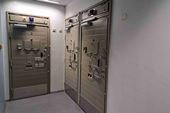“To reap the benefits of connected security, businesses need technologies which are primed and ready to work seamlessly with each other,” comments Thomas Schulz, EMEIA Product Marketing Director, Assa Abloy Opening Solutions. In a recent survey of security professionals – published in “The Wireless Access Control Report 2021” by Assa Abloy Solutions – over 90 percent of the responders noted the critical importance of integration across building management functions. But what exactly are the benefits – and how can organisations deploy effective strategies to realise them, even with a limited budget? An 18-page white paper, “Boosting efficiency and streamlining security with an integrated access control solution”, from experts at Ifsec Global and Assa Abloy Opening Solutions, responds to these questions, providing the detailed background which key decisionmakers need before launching an integration project.
Education sector
Thomas Schulz explains that the report examines the growing role for integration within and beyond building security. It highlights the benefits – in cost control, employee and energy efficiency, security and more – for businesses with integrated security systems and process.
”The concrete benefits an organisation can expect vary from case to case. The white paper studies real-world hardware integrations in the healthcare and higher education sectors in two European countries. It considers the cost and efficiency impact on the organisations which integrated access control effectively,” he states and continues with an example from the report.
“At the Inholland University of Applied Sciences, a Nedap AEOS system integrated with Aperio wireless devices is able to control access for seven different campuses from a single, integrated point. A new university site in Amsterdam will be developed as a ’smart building’, incorporating many of the same interoperable technologies integrated with an intelligent building system.”
Health care sector
Thomas Schulz also mentions an example from the healthcare sector.
“At Centre Hospitalier Métropole Savoie in France, a single ARD system integrates Aperio locks for building access and security with an internal HR management system and the French government’s electronic Health Professional Card. Having a single credential for multiple uses increased efficiency for both security administrators and medical staff.”
Long-term and short-term benefits
The paper examines how integrated solutions reward businesses in both the short and the long term. It states that “in the short run, integrated security can make employee workflows more efficient, as those real-world cases show. When facilities staff only consult or update a single interface, rather than multiple systems, they save time and reduce manual errors.”
Looking further ahead, integration helps businesses to retool their building management for the challenges of the 2020s. The smart building is integrated, automated and future-proofed.
“Whereas security has mostly been a reactive profession prior to now, integrated solutions allow data to be transformed into knowledge,” explains Danny Laurier at Securitas, in an exclusive interview for the white paper.
“And, when you have knowledge, you can move from a reactive to predictive risk management approach.”
How to deploy security integration
What information must company decision-makers digest to assess their specific case for greater security integration? How can they choose the best off-the-shelf integrated or integratable solutions?
Of immediate practical use, the report examines different types of integration and the technologies required to make each work. It explains how deployments can be made even when faced with tight budgets and a demand for concrete returns on investment, including for high-demand access control integrations such as visitor management and video surveillance.
Look over interoperability
Ensuring an organisation buys and plans for interoperability in both hardware and software is critical.
“As well as being more flexible, solutions developed to compatible, shared standards are better futureproofed,” explains Russell Wagstaff, EMEIA Platform Director at Assa Abloy Opening Solutions.
“Standards ensure investments can be made today with confidence that hardware and firmware can be built on seamlessly in the future. Compatible solutions, ready to integrate with multiple different systems, offer greater peace of mind than proprietary technologies which ‘lock you in’ for the long term.”

















